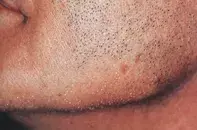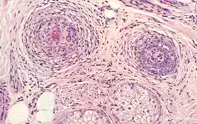What’s the diagnosis?
A young man with a patchy beard


Black dot tinea is an infection in which the hair shafts are parasitised by fungi. The hair shafts are fragile and often break close to the skin surface, producing black dots. A clue to the diagnosis may be the presence of scaling, erythema and pustules. Black dot tinea can be confirmed by examining or culturing plucked hairs for fungi.
Follicular mucinosis is a relatively rare disorder in which the follicles and sebaceous glands undergo mucinous degeneration. Usually there is associated erythema, and mucin may sometimes be expressed by squeezing the skin. In some cases there may be associated comedones or dilated follicular openings and keratin plugs. In adults this disorder may be associated with a cutaneous T cell lymphoma.
Alopecia areata can be localised to the beard area and is the correct diagnosis in this case. A skin biopsy showed lymphocytic inflammation that was concentrated around the hair bulbs (Figure 2). These T-cell lymphocytes inhibit the growth of hairs. The hair follicles are usually not destroyed and regrowth may occur spontaneously or with treatment as the stem cell compartment in the upper follicle is preserved. Initial regrowth may consist of white hairs because the lymphocytes can selectively destroy the melanocytes in the hair bulbs that are responsible for hair pigmentation. For localised patches of alopecia areata, intralesional steroids (triamcinolone acetonide 10 mg/mL, diluted to 2.5 to 5 mg/mL) may be infiltrated at multiple sites of the alopecia. This should be repeated at four- to six-week intervals, depending on the response. Treatment may not be necessary as spontaneous regrowth may occur with time.
Over a six-month period, a 24-year-old man noted a progressive loss of hair within his beard region (Figure 1). Some of the hairs had returned as a white stubble but had failed to grow.

